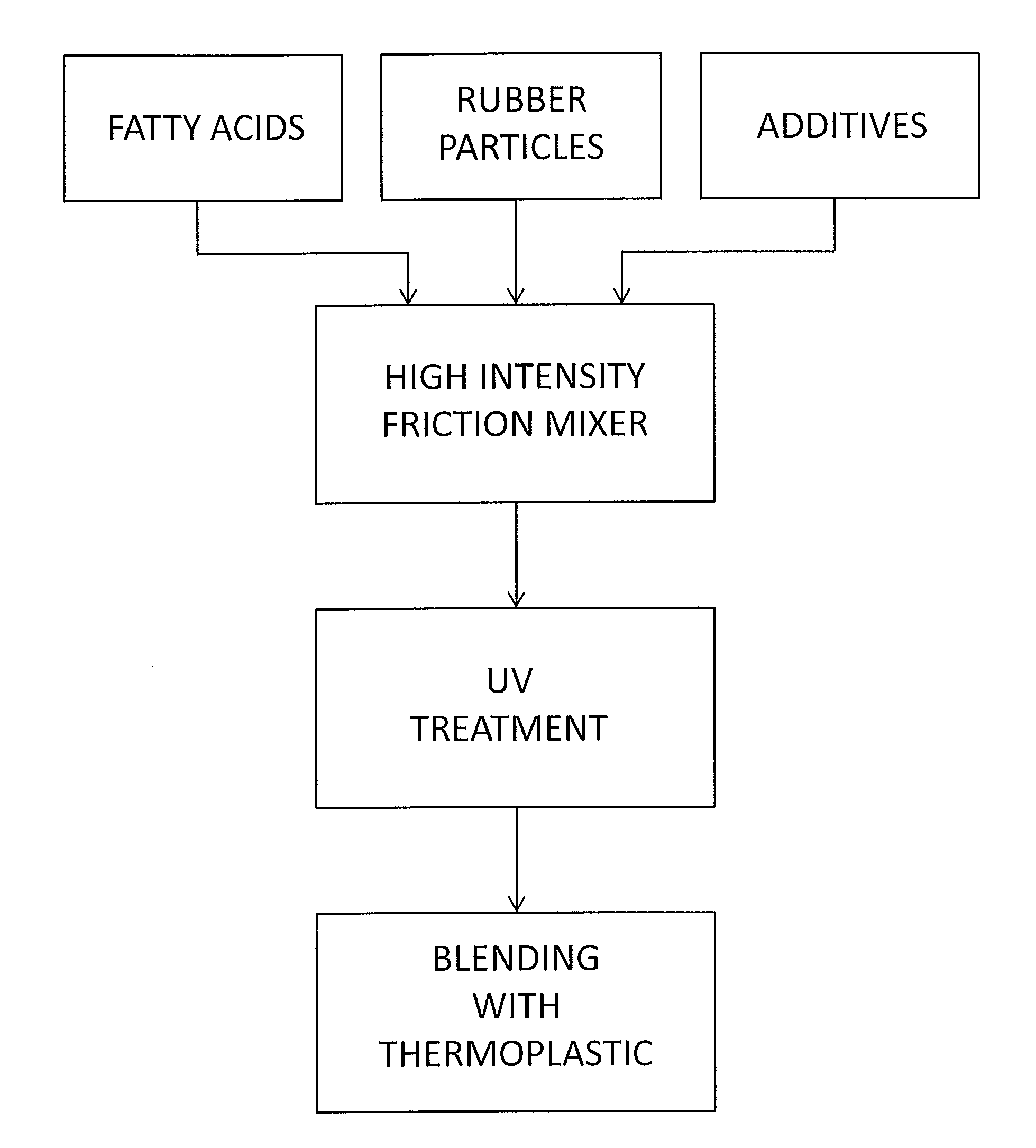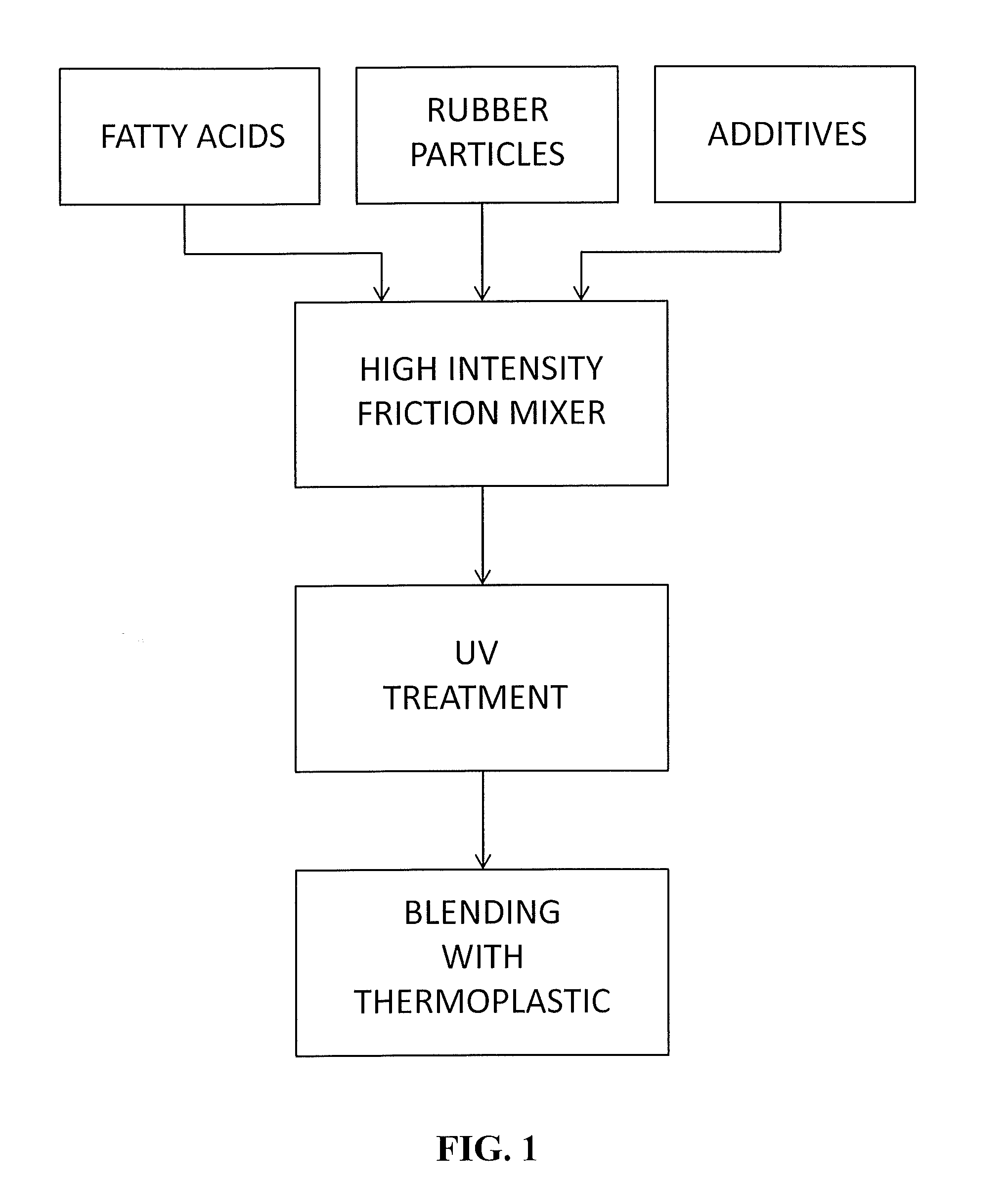Method and System for Treating Elastomers and Articles Made Therefrom
- Summary
- Abstract
- Description
- Claims
- Application Information
AI Technical Summary
Benefits of technology
Problems solved by technology
Method used
Image
Examples
example 1
[0039]1,200 pounds of particulate rubber from used tires (SBR) or industrial rubber having a particle size of minus 40 mesh are placed in a commercially available Henschel HIFM having a capacity of 1,500 liters. The HIFM is operated at an impeller rotational speed of from 1,485 to 2,970 rpm, which results in a vortex flow pattern of the rubber particles and frictional heating of the particles with no externally applied heat source. After about 11 minutes, the frictionally heated mixture reaches a temperature of 200° F. Mixing is continued while adding 39 pounds of tall oil. After 10 minutes of mixing the rubber particles and tall oil, 26 pounds of silane coated talc or micro talc and 26 pounds of LLDPE are added to the HIFM, and the mixing is continued for another 4 minutes. The resulting mixture is removed from the HIFM, cooled and subjected to UV treatment by exposing the mixture to an 800 watt per inch UV lamp for 1 to 3 seconds. 25 pounds of the resulting mixture are blended wit...
example 2
[0040]1,200 pounds of particulate rubber from used tires (SBR) or industrial rubber having a particle size of minus 40 mesh are placed in a commercially available Henschel HIFM having a capacity of 1,500 liters. The HIFM is operated at an impeller rotational speed of from 1,485 to 2,970 rpm, which results in a vortex flow pattern of the rubber particles and frictional heating of the particles with no externally applied heat source. After about 11 minutes, the frictionally heated mixture reaches a temperature of 200° F. Mixing is continued while adding 39 pounds of fatty acid concentrate derived from soya oil. After 10 minutes of mixing the rubber particles and concentrate, 39 pounds of silane coated Wollastonite, 24 pounds of Struktol dispersing agents comprising 75 percent Struktol 28 and 25 percent Struktol 016, 12 pounds of Aktiplast F cross-linker and 24 pounds of LLDPE are added to the HIFM, and the mixing is continued for another 4 minutes. The resulting mixture is removed fro...
example 3
[0041]1,200 pounds of particulate rubber from used tires (SBR) or industrial rubber having a particle size of minus 40 mesh (400 microns) are placed in a commercially available Henschel HIFM having a capacity of 1,500 liters. The HIFM is operated at an impeller rotational speed of from 1,485 to 2,970 rpm, which results in a vortex flow pattern of the rubber particles and frictional heating of the particles with no externally applied heat source. After about 11 minutes, the frictionally heated mixture reaches a temperature of 200° F. Mixing is continued while adding 39 pounds of fatty acid concentrate derived from soya oil. After 10 minutes of mixing the rubber particles and concentrate, 39 pounds of silane coated Wollastonite, 24 pounds of Struktol dispersing agents comprising 75 percent Struktol 28 and 25 percent Struktol 016, 12 pounds of Aktiplast F cross-linker and 24 pounds of LLDPE are added to the HIFM, and the mixing is continued for another 4 minutes. The resulting mixture ...
PUM
| Property | Measurement | Unit |
|---|---|---|
| Temperature | aaaaa | aaaaa |
| Temperature | aaaaa | aaaaa |
| Temperature | aaaaa | aaaaa |
Abstract
Description
Claims
Application Information
 Login to View More
Login to View More - R&D
- Intellectual Property
- Life Sciences
- Materials
- Tech Scout
- Unparalleled Data Quality
- Higher Quality Content
- 60% Fewer Hallucinations
Browse by: Latest US Patents, China's latest patents, Technical Efficacy Thesaurus, Application Domain, Technology Topic, Popular Technical Reports.
© 2025 PatSnap. All rights reserved.Legal|Privacy policy|Modern Slavery Act Transparency Statement|Sitemap|About US| Contact US: help@patsnap.com


